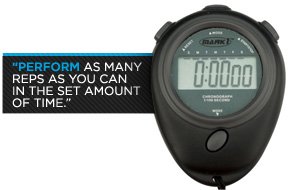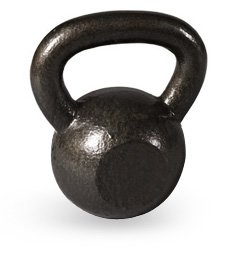You like your lifting program—a lot. It took you a long time to find such a perfect blend of compound and isolation lifts, and it helped you achieve some big goals.
But then your goals got bigger, leaving your program behind. Now, you're not seeing the same steady progress. You've lost that lovin' feeling, but you don't want to completely change your program. You just want that same pump you felt in the old days!
Don't panic, and don't abandon the routine you love. Instead, incorporate a few minor technique tweaks to keep things fresh and revitalize your results. Consider these plateau-busting tips:
1 // Time Your Reps
Selecting your rep range is normally one of the first parts of program generation. It's a crucial way to set your goals and track your progress. After all, if you didn't have reps, what would you write down in your workout log?

There are other ways you can track how much you lift. For the next week or two, lift for time. Choose a defined timeframe—45 seconds for moderately heavy weight, 20 seconds for heavy weight—and perform as many reps as you can until the proverbial (or real) buzzer sounds.
If you have to stop at any point, that's OK, but start again as soon as possible. This will teach your body to work through fatigue and help boost your muscular endurance. Fast reps may also help you generate more force. The change in stimulus might be enough to boost your growth!
2 // Increase Your Time Under Tension
This technique earns top marks for increasing muscular endurance and busting through training ruts. Increasing time under tension (TUT) involves more motor units, which cause more muscle fibers to contract. Using more muscle fibers can help you increase strength, endurance, and training efficiency.
To increase TUT, start by moving through your standard rep cycle all the way through to your target number. On the last rep, hold the weight stationary at the top (or bottom) of the movement pattern. Hold until failure, and then finish the rep.
If you want an even greater challenge, hold the rep halfway through the movement. For most people, the middle of a movement is the most difficult, the location of the most muscular tension. Good athletes focus on their weakest points. That's why they're good.
3 // Switch to Cable Training
If you've been lifting free weights for as long as you can remember, switching to cables can offer a fantastic change of pace and give your muscles an entirely new stimulus to battle.
Cables are going to change the leverage of a lift, offering continuous tension whereas free weights don't. For example, during a dumbbell or barbell curl, the lift gets easier at the top and bottom of the lift because of better leverage. However, switch to cables and you'll have equal tension throughout the range of motion.
For bodybuilders, implementing cable training is advantageous. The same amount of weight will feel different than it does with barbells or dumbbells. The result: adaptation.
Enjoy your cable vacation, but remember that proper form matters just as much on a pulley system as it does with free weights. The risks are just as real. Lift with the same controlled pace, and resist the urge to cheat.

4 // Find a New Training Partner
Look around next time you're at the gym, and you'll see that at least 75 percent of the iron warriors are lone wolves, lifting away in solitude. Only 25 percent of people training have a partner. In this case, the minority is onto something.
Having someone there to motivate you through your workouts can breathe new life into your gym experience, perhaps even more effectively than a new training routine. If possible, find someone who is slightly more advanced than you, and see if that doesn't give you that bit of extra energy you didn't know you had.
Even the most talented and successful athletes in the world need a partner to keep them accountable and push them to improve. Professional athletes have to pay for their buddies; hopefully you can get yours for free.
5 // Utilize Body Weight Exercises

Body weight and free weights aren't natural enemies. They make powerful allies. Using body weight exercises after weightlifting will help to push your body beyond its normal point of fatigue. Adding plyometrics to your weight training can help you generate more power and stimulate hypertrophy. Studies have indicated that the combination of the two works better than either does alone.
To use this technique, perform your normal weightlifting movement, and when you've finished the set, drop down and do a corresponding body weight movement. After the bench press, incline chest press, or shoulder press, push-ups would work as a finishing exercise. A push-up variation like triangle push-ups would nicely complement any triceps isolation exercise.
After lower-body movements, you could also perform a set of body weight squats. Following any back or biceps movements, try pull-ups.
When you're doing your body weight movements, focus on acceleration. This will recruit more motor units translating to more fatigued muscle fibers. The more muscle fibers you enlist, the faster you'll develop that X-Frame you've been 'mirin.
Because you're doing more volume, you may have to reduce your total set count. After implementing body weight movements in conjunction with resistance training, you'll have a rough time getting out of bed in the morning.
6 // Try Kettlebell Training

Kettlebell training isn't just a gimmick. Switch to these classic Russian weights for a month, and you'll find yourself so challenged you may not want to ever sit in a pec deck again.
Doing swings, clean-and-jerks, and presses with kettlebells can replace many of the standard compound exercises. Don't be surprised if you notice extra fat loss or core activation either; kettlebell training produces both.
Don't hesitate to combine kettlebell training with your typical weightlifting regimen. You can also use kettlebells for cardiovascular conditioning. Try one- or two-handed swings for time.
7 // Reverse the Order of Your Compound Lifts
Reversing the order of your compound lifts is a fast and straightforward adjustment that can dramatically affect how your body is stressed. For example, a typical compound-heavy chest routine might be:

If you reverse the compound lifts, the routine would be:
The flye still goes last because it's not a compound movement. This tip might seem simple, but sometimes simple tweaks lead to dramatic results. Don't abandon the workout you love; adjust it!

